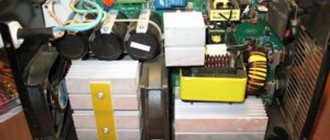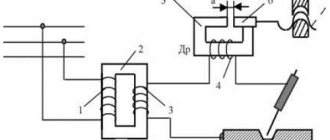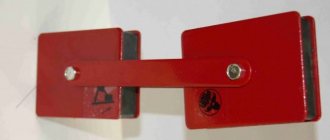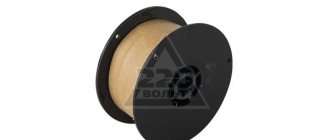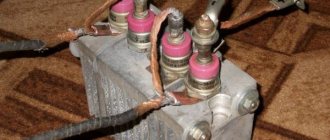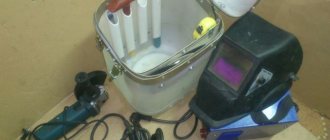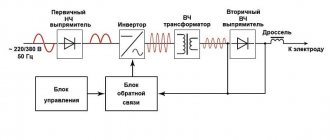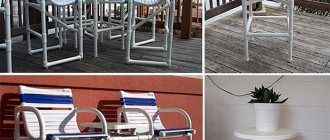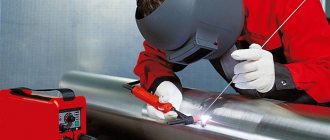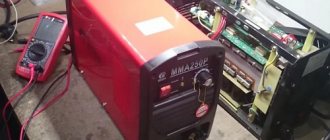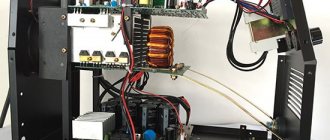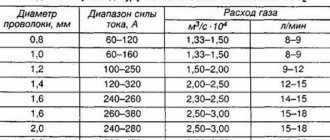Factory made holders
- Collet; Quite a convenient option. Replacing the cinder with a new electrode is effortless. Looks aesthetically pleasing. Advantages : ergonomic handle, excellent protection of the welder from temperature and electrical influences. The disadvantage is the high cost and restrictions on the maximum welding current. Do not leave a short stub - there is a high probability of damaging the handle.
- Clothespin; The most common factory design. Available in a variety of sizes, for any welding currents and electrode diameters. It’s not very convenient due to the protruding lever, but the reliability makes up for the ergonomic shortcomings. Advantages - there are practically no current restrictions, very reliable contact with the electrode, no additional equipment is required to change the cinder. The disadvantage is the bulky design; installing a new electrode requires a lot of force.
- Fork (trident). The most famous and popular option, especially for welders of the old Soviet school. At the same time, it is the most controversial design. Today it is not available for sale; only old copies can be found on the secondary market. The reason is prohibited by safety standards due to the high probability of getting radiation burns to the eyes. Advantages : phenomenal simplicity of design. Disadvantages : high incidence of injuries, poor contact with the electrode, additional equipment is required to remove the cinder.
Homemade designs
Trident
This is simply a welding classic. There is hardly an electric welder who has not held in his hands a “fork” welded from three pieces of corrugated fittings. A piece of rubber hose or a handle from a bicycle handlebar was usually used as a dielectric handle. Sometimes they just made do with rag tape.
The option is the simplest to manufacture, however, it is quite inconvenient and dangerous during operation. The biggest problem is removing the cinder. Due to the design features, the electrode was used almost completely - this was always presented as one of the advantages.
In this case, the cinder was removed using a hammer or pliers. You've probably seen more than once a picture of a welder pounding a holder on the asphalt, knocking out the remaining electrode from it. Another disadvantage is poor contact.
Typically, welders attributed a failed weld to “bad electrodes”; in fact, the loss of current is caused by rusty oxides on the surface of the reinforcement. Therefore, a file for stripping is an invariable companion of such a device.
A more advanced option is a rod welded to a metal corner.
This design is more reliable, the electrode is held firmly and the electrical contact is good. There is only one drawback - it is still difficult to replace the cinder with a new electrode.
Trident with spring
Upgraded version of the previous model
This design is made from high-quality steel, preferably stainless steel, to ensure reliable contact. The central finger springs the electrode, which makes changing the cinder somewhat easier.
The design, as well as the materials used, are clearly visible in the figure.
There is only one drawback - expensive materials (stainless steel). At the same time, the cost price is significantly lower than a factory product.
How to make a homemade holder with a spring is detailed in this video.
Collet (threaded) version
The design is reliable and easy to use. There is only one drawback - troublesome production. The technology of the product can be seen in the drawing.
You can make such a holder with your own hands from any metal. The main thing is reliable contact of the welding cable.
Collet (clamping) version
Technical development of the previous version of the holder. Instead of a threaded connection, a spring clamp is used. The obvious advantages of the design are the ease of changing the cinder to a new electrode. Again, a compromise option. The more powerful the spring, the more force is applied to replace the electrode.
But at the same time, the reliability of the contact, and therefore the maximum current value, increases. Conversely, operating comfort reduces the current load. No less important is the second connector, which supplies current to the welding object - ground.
It does not need to provide thermal and electrical protection. But the contact must be extremely reliable. Otherwise, due to resistance, the current strength decreases and welding efficiency decreases. It is best to choose a copper or brass clamp. The cable attachment should be as close as possible to the point of contact with the metal.
If there is sparking at the place where the earth clamp is attached, in addition to current loss, you can get stuck to the workpiece. This will ruin both the clamp and the metal being processed.
Read also: How a solenoid valve for water works
During operation, it is often necessary to move the holder a long distance from the transformer. In order not to limit yourself too much in distance, there are extension cords for both the supply and working cables. A welder's power extension cord is not much different from a regular one. Several requirements are taken into account. Operating current is not lower than 25 Amperes.
Heat-resistant flexible insulation. Reliable plugs and sockets, preferably with a mating lock. If we are talking about a work cable extension, then its cross-section should not be smaller than the main wires. The connection method is also special - special bayonet connectors are used.
Then current losses in the connectors are eliminated.
And this video explains in detail what to look for when choosing a holder for a welding machine.
For a professional welder, and even for an amateur, a good electrode holder is the key to comfortable and convenient welding. When purchasing a holder, you need to know how to choose a much-needed item for welding work, what points you need to pay special attention to, so that later problems do not arise when using it.
DIY welding electrode holder
Despite the reliability of the factory designs of welding machines, during operation, some of its parts may fail, including the device for holding the electrodes. Of course, you can purchase these spare parts in the store. They are widely available for sale, but the vast majority of professionals prefer to install a homemade electrode holder. Its design is simple, but it must strictly meet certain standards:
- the homemade product must provide dielectric protection for the welder;
- the welding holder must be well insulated;
- wires must be fastened securely and efficiently;
- the holder must withstand electrical currents of several hundred amperes;
- the electrode must be held as tightly as possible;
- Replacing electrodes should be simple and quick.
The last two requirements actually contradict each other, so a homemade welding holder is always a compromise for the master.
Holder for a factory-made welding machine
Manufacturers offer three modifications of welding holders:
- Collet holder for electrodes. This is an easy-to-use option. Replacing the cinder with a new electrode is easy, performs excellent protective functions and looks aesthetically pleasing. But the collet is expensive and has a current limitation. In addition, it does not allow you to save on electrodes, since it is forbidden to leave a short cinder.
- Holder for welding - clothespin. The most popular offer from manufacturers. Manufactured in a wide range of sizes, electrode diameters and welding currents. The clothespin is not very convenient to use, but it is very reliable. It is characterized by good contact with the electrodes, no restrictions on electric current, and does not require devices. Its disadvantages are the problematic change of cinder and large dimensions.
- Trident or fork. This modification of the holder for welding equipment has practically fallen out of use because it does not comply with modern standards. The trident is a Soviet standard.
How to make a welding holder with your own hands
Similar to factory designs, a holder for a welding machine is made with your own hands. There are many technologies for making a device, but the most common are the following designs:
- Trident. This is a classic DIY version of the device. Back in Soviet times, welders made their tools precisely according to this principle. The holder is a fork welded from three corrugated pieces of reinforcement. A bicycle handlebar handle or a fragment of a rubber hose is used as an insulator. In some cases, rag insulating tape was used as the dielectric of the holder for do-it-yourself welding. This design is easy to manufacture, but dangerous and inconvenient to use. It provides poor contact with the electrode, the cinder is difficult to remove, and the fittings are constantly oxidized. Soviet welders offered very original ways to make a welding holder. One of the most successful designs is a reinforcing rod welded to a metal corner. Its only drawback is the difficulty of replacing the cinder.
- Trident with a spring. This is an improved version of the DIY welding machine holder described above. This is the same fork, but the tines are located almost in the same plane. The electrode is inserted between the fingers, the central one springs it. This DIY welding holder is made from expensive materials such as high-alloy stainless steel. The contact with the electrode is strong, changing the cinder is quite easy. Rubber is used as the dielectric of the do-it-yourself welding machine holder to protect the welder.
- Threaded collet. The holder can be made of any metal. It provides reliable electrode contact, easy replacement of the cinder, is reliable and easy to use. Its disadvantage is the complexity of manufacturing. Design features are indicated in the drawing.
- Clamping collet. This is a modernization of the threaded collet model. Instead of threaded fasteners, a spring mechanism is used. The advantages of the design are obvious - the ease of replacing the cinder and the reliability of fastening the electrodes. Before wondering how to make a holder for welding this design, it is necessary to carefully analyze the electrical circuit. The more powerful the spring, the more reliable the contact, and the maximum current strength increases. If you use a weaker clamp, the current load is reduced. It is important to provide a second connector here, which supplies current to the ground. Although it does not need to provide electrical and thermal protection, the contact should be as reliable as possible. It is better if the clamping mechanism is made of brass or copper.
Device
Let us briefly consider the design of the electrode holder. Several important factors depend on the design of the device:
- quality of welded joints;
- master's labor productivity;
- convenience and safety of work.
inexpensive electrode holder
A standard type holder is a tool consisting of several parts: body, clamp, handle, moving parts. But different species may have some structural features . More details below.
Let us briefly consider what types of electrode holders exist. Electrode holders are divided into universal and specialized . The production of both groups is regulated by GOST standards. For homemade ones, see the separate subheading below.
The universal electrode holder is the most popular, as it allows welding in various spatial positions.
There is also a more detailed classification:
1. Clamping clothespin holder (spring or lever) is characterized by a simple design and low price. The main disadvantage is weak fixation of the electrode.
This type can be made in two modifications:
- simple is compatible with most types of welding machines and the complete absence of non-insulated areas;
- automated ensures high seam quality, significant energy saving and automatic arc ignition.
2. Screw electrode holders allow the cathode to be firmly fixed. The main disadvantage is the need to constantly unscrew and tighten the screw in the clamping device when changing the material for welding.
We suggest watching a video where the user compares two holders, a screw one and a clothespin, and makes a choice in favor of the screw one.
3. The design of non-flammable is designed in this way: the electrode is not fixed with a clamp, but is welded to the end of a rod with an insulated surface and completely melts during the joining process. Then the next rod is taken.
4. Quite popular among welders of any level is the trident fork . However, this type, made in a simple modification, poses a serious threat to the health of the master due to the large number of unprotected parts.
Homemade fork holder
5. The collet holder is used in argon arc welding torches.
6. The electrode holder with a rotary type clamp allows you to quickly and reliably fix the rod at only one angle.
In addition to the above types, there are also special-purpose units that are used to create a certain type of seam.
The simplest DIY welding electrode holder - Do it yourself
The welding business is developing by leaps and bounds: new types of equipment make welding accessible, useful and interesting for beginners and professionals. Let's add one more word - “comfortable” business.
What does it mean to work “comfortably”? This means convenient, pleasant and effective. This comfort is added by various modern components. These, of course, include the electrode holder, whose new and varied forms have appeared on the market in large numbers.
What is the correct holder
What is he doing? In short, it controls the electrode during welding: it secures it and supplies the welding current. Hence the desirable properties.
Functions and technological properties that a welding holder must have:
- provides strong fixation of the electrode with a changing angle of electrode exit;
- gives reliable and complete electrical contact;
- durability;
- capable of quickly replacing electrodes;
- should be light weight so that the hand does not get tired. The usual weight of the holder is about 350 g. For a current of 500A, the device is more powerful and can weigh up to 750 g;
- Mandatory ergonomics: comfortable position in the hand, requiring no effort.
One of the classic stereotypes is buying a larger and more powerful device with a pipe dream in your head that it will work longer and better. In reality this does not happen. This also applies to the welding holder.
Classification of electrical holders
Generally speaking, these devices are divided into two large groups: specialized and universal, regulated in GOSTs.
Homemade electrode holder.
The most popular types of universal holders are as follows:
- A clamp-type clothespin holder can be presented in two versions: spring and lever. This device, which can be called an electrode clamp, has an extremely simple design and low cost. It is compatible with almost all welding units. Provides excellent characteristics: good arc ignition, high quality seam and, importantly, energy savings.
- The trident fork is perhaps the most common version among professional welders. There are some nuances associated with these electrode holders for manual arc welding. The fact is that in its traditional form it is poorly protected: many parts are energized, which carries a high risk of harm to health. In addition to electrical injury, there is a risk of additional radiation injury. There are, of course, modified automated models that are considered safe and show good technological performance.
- The holder is a clamping type collet used in a narrow direction: only in torches for argon arc welding.
- Screw holder in several versions: the clamp can be straight or curved with different thread directions - both left and right.
- The flameless holder works on a different principle. True to its name, it prevents the occurrence of cinders and reduces the fastening time of the consumable, which is not secured with a clamp, but is welded to the end of the electrode so that it will eventually melt during welding. After this, the next consumable is taken.
The second group of welding machine holders refers to specialized models for working with specific products and types of seams. Examples are a specialized device for welding simultaneously with several electrodes or for welding with a three-phase arc. For the most part, such models are complex and have considerable weight.
Choosing the right model
When choosing a working device, craftsmen have different considerations. For some, the price criterion is more important, for others - security guarantees. But more often than not, the type of work is the most important. The situation is the same with electrode holders for welding. Efficiency and safety come first.
Here are the parameters to take into account when choosing the best option:
Dimensions
Electrode holder designed by Anikin.
What is behind the concept of ergonomics? This is compactness and suitable dimensions for the specific hand of the master, light weight. If you have a line of welding holders with the same technical characteristics, choose the one that is lighter and smaller in size.
If you travel to different work sites, purchase a second spare welding holder.
Degree of reliability
The reliability of the devices is tested under non-standard operating conditions. Holders for welding must work reliably and without loss of their qualities at critical temperatures, high humidity, dust contamination, etc. The plastic of the handle should be durable with good insulation.
It is better if the clamp is cast and massive. Screw electrode holders with rigid threaded fixation are very reliable. They are the most durable in operation and, in addition, make it possible to change the angle of the cathode end.
Price
The range of prices is impressive: from one hundred rubles to fifteen thousand. Of course, the cheapest models, by definition, cannot be considered safe or reliable. If you are not going to buy disposable equipment, you need to pay attention to the average price categories of models.
DIY power holder
Varieties of homemade holders.
Screw model
How to create a screw model of a holder:
- A copper tube can be used to make an excellent holder for a screw-type welding machine. Scraps of copper tubing can be found in abundance at air conditioner installers. Typically this is a pipe with an outer diameter of 19 mm.
- The handle can be made of a metal-plastic pipe with an outer diameter of 26 mm. The best option would be a rubber hose. The handle must be pulled over the copper tube so that it completely covers it.
- The handle should be wrapped in a piece of jacket or glove so that it does not slip in your hands.
- The final step will be to glue an M12 size bolt with a through hole into the cap of a plastic bottle. Your homemade electrode holder is ready.
Electrode holders for both manual arc welding and argon welding are an excellent help for craftsmen for ease of work and improving the quality of products. These devices can be purchased, or you can make them yourself. The main criteria in all cases are safety, stability and reliability.
Source:
Making a welding holder with your own hands
In production, construction and everyday life, electric welding is a very important process. Along with the choice of electrodes and welding machine, attention must also be paid to the welding electrode holder. At the moment, there are a huge number of clamps that differ from each other in design, weight, and so on. In addition, you can make a welding holder yourself. In this article we will talk about how to make a holder for a welding machine with your own hands.
Requirements for holders
The electrode holding device is a very important component, although its design is quite simple. The following are some requirements:
- adequate dielectric and thermal insulation protection must be provided;
- the wire must be fastened securely;
- reliable retention of the rods must be ensured;
- The cinder should be easily replaced with a new rod.
Factory fastener models
Before considering a homemade electrode holder, you should learn about factory models. There are several types of them.
A good electrode holder should:
The electrode holder must meet the following mandatory requirements:
- Reliability and confidence in fixing electrical conductors of any diameter in the required position.
- Possibility of quickly changing the electrode exit angle.
- Good and complete contact .
- Ensuring quick electrode replacement.
- Durability of use.
- Lightness of the device.
- Insulation of live parts.
- Possibility of welding in hard-to-reach places.
How not to buy a low-quality holder for a welding machine
Live parts of a quality device must be made of copper and protected with insulating material. Some unscrupulous companies manufacture live parts from steel and then coat them with copper. Thus, the parts become very hot and burn quickly.
They look like copper and it is difficult for a non-professional to visually distinguish them from “all-copper” parts. There is one surefire way that requires a magnet. It is necessary to bring a magnet to the part being tested; if the parts are magnetic, then they are made of steel.
Copper jaws of the holder
DIY options
A homemade holder can cause electric shock.
It has exposed conductive elements and a poorly insulated handle. How to do it yourself? Most often, craftsmen make a trident . Its structure is so simple that a drawing is not needed. Three rods of mild steel, usually reinforced, intended for building structures, are slightly curved at the bottom, connected and wrapped with copper wire at the bottom. Then a handle made of insulating material is placed on the wire.
Popular manufacturers
Let's move on to popular manufacturers of electrode holders.
Telwin is a world leader in welding machines, cutting systems and chargers. The Italian company offers holders under the same brand.
Spring electrode holders for welding work from the German company ABICOR BINZEL are distinguished by the following characteristics: high-strength and heat-insulating handle; rigid fixation of the dynode in four positions; ergonomics; strength; versatility of use.
Trafimet was founded in 1974 in the Italian city of Vincenza . The manufacturer offers spring-type tools with the following technical parameters: low weight of the unit; reliability; ease of use.
The Russian company produces inverter equipment. Holders from this manufacturer are manufactured in compliance with all state standards; allow welding in all positions, as well as in hard-to-reach places.
Read also: Spray gun ulig 050 00
The Swedish concern
ESAB is one of the world leaders in the production of equipment, materials, accessories, protective equipment and other accessories for welding.
The wide range also includes screw-type electrode holders, characterized by maximum safety and quality of work. See the video above. EWM 's head office and production are located in Mündersbach, Germany. The company specializes in the manufacture and sale of a wide range of equipment, including electrode holders of various types.
The Russian brand BRIMA occupies one of the leading positions in the market of equipment, components and materials for welding. Electrode holders are designed for three groups of consumers: household, professional and industrial.
SANTOOL a reliable manufacturer and supplier of quality welding products. The equipment is produced under several brands. The devices have a reliable fixation, electrically conductive parts are insulated from accidental contact.
The Russian company Skrab sells products under its own brand of the same name, and also supplies professional equipment from leading manufacturers. The equipment is used in many fields of activity.
SIBRTECH is a domestic manufacturer of high-quality tools and equipment. The company offers clamp-type electrode holders. When working with units, it is important that the electrically conducting parts do not come into contact with the product being welded or with human hands. regarding the products of this manufacturer , watch the video above and below .
The Italian company Quattro Elementi is engaged in the manufacture and sale of equipment, materials and accessories. Ergus brand .
Kord company is the largest Russian manufacturer of innovative equipment and accessories for welding. The clamps presented in the assortment are created in accordance with GOST standards and have different types of design.
In 2014, the Moscow company opened its own production of electrode holders and grounding terminals under the Saturn . The clamps are easy to use and are ideal for both domestic and professional level welding inverters.
Specifications
All electric welding equipment is characterized by current strength and rated voltage. In addition, the electrode holders are characterized by the following data:
- good contact with current supply elements;
- strong fixation of the electrode;
- reliability;
- dimensions;
- quality of insulating material;
- rotation of the electrode relative to the handle;
- guaranteed service life.
In terms of power and load-bearing capacity, the electric holder is available for household and professional use . The type of work determines whether the gas burner is built into the holder or attached.
Why buy a welding holder separately if it is already included with the welder?
Beginning welders often ask the question: “Why buy separately holders for a welding machine if the inverter is already equipped with a clamp?”
The standard holder from the inverter is broken
The answer to this question is quite simple: such an electrode holder is of low quality, and accordingly it will not work for long. In addition, unscrupulous manufacturers often use cheap materials to make components for the inverter. This has a positive effect on price and a negative impact on quality. Most often, the clamping jaws fail; they burn out and no longer provide fixation of the rod.
How to choose
Choosing a tool is a responsible task designed to make further work safe and efficient, and a welding electrode holder is no exception. Let's consider what should be taken into account when choosing what parameters.
1. Amperage. The electrode holder must match the current strength of the welding equipment used. So, when using a welding inverter with a current of 300A, connecting to it a holder that is not rated for 150A is not a very good idea. The electrode holder in this mode will last no more than two days, since the electrode clamp will burn and fail. In addition, using a holder with a lower amperage is simply not safe.
In the opposite situation, when holders are purchased “with a reserve”, that is, a 300A holder is installed on a 160A device, the solution is safe, but not very convenient for operation. With a higher amperage, the dimensions and weight of the holder are larger (which will affect the welder’s fatigue and the ability to get into hard-to-reach places, see the following requirement) , since the insulation is thicker, the cast parts, and the electrode clamp are more massive. Therefore, it is necessary to select a holder based on the strength of the welding current.
2. Dimensions and weight. For convenience, the device should have low weight and small dimensions. Extra grams will in no way affect short-term work, but during long-term processes that require attention and accuracy, a heavy unit can cause discomfort and muscle tension . Therefore, when choosing from several models with similar technical characteristics, you should give preference to the lighter and more compact one.
Dimensions and weight of welding holders - feel the difference
3. Work is often carried out under unfavorable conditions: dust, dirt, humidity, too high or low temperatures. Compensation for these factors should be the high reliability of the electrode holder. The body of the device is most often made of plastic with high insulating properties. When it comes to clamping, professionals prefer a molded one, since plate type jaws are more prone to failure. The most reliable option is a screw device; its threaded fixation guarantees an unambiguous position of the rod.
4. Well-known manufacturers maintain their reputation and carefully control the quality of their products. Therefore, proven brands are in high demand among consumers. Here it is worth adhering to the principle of sufficiency - an inexpensive holder from an unknown manufacturer will most likely not last even a month at a shipyard if it is operated in two shifts, but for an amateur welder it will last for two or three seasons, or even longer.
5. The next, most important one, cost, directly depends on the previous factor. The price varies widely. Cheap models, by definition, cannot be distinguished by a high level of quality and reliability, thoughtful design, and in rare cases they are designed for long-term operation. But an inexpensive tool is well suited for an amateur welder to perform one-time work. On the other hand, to carry out household welding there is no need to buy an expensive device, which is necessary for professional and industrial scales.
Read also: How much does a kilogram of copper weigh?
6. The greatest demand among customers is for units capable of fixing electrodes of any diameter . Since such devices are universal and can be used for a variety of work.
What to look for when choosing
First of all, it should be taken into account that high-quality electrode holders for welding machines have current-carrying parts made of copper. For fakes, they are made of steel coated with a thin layer of copper, which quickly fades. In appearance they are indistinguishable from the originals, so a magnet will be needed to check.
The holder for welding is selected according to the following criteria, taking into account the characteristics of the work:
- Weight and dimensions. For periodic welding at home, these parameters are not critical. However, for long-term work it is better to choose a lightweight model, since holding extra grams for a long time will be tiring.
- Performance characteristics. The maximum current of the holder should be 10% greater than that of the welding machine. At a lower value, the points of contact with the electrode will quickly burn out. However, you should not get carried away with increasing the current reserve, since the dimensions and weight will increase, but the service life will not change.
- Reliability. For a welding holder for outdoor use, the handle material must be resistant to low temperatures and high humidity. Models with cast jaws will last longer than those with type-set jaws. Screw welding holders with a threaded clamp are considered the most reliable in terms of the method of fastening consumables.
- Method of connection with welding cable. The best option would be a bolted one. It is not worth spending money on holders made in China with a crimp connection method.
- Diameter of electrodes. When choosing, you need to pay attention to the diameter of the welding rods the holder you like is designed for. Otherwise, it may happen that the purchased model is designed to work with consumables from 5 mm, so it does not clamp the “four” or less.
- Price. Manufacturers offer welding holders at prices ranging from 100 to 10,000 rubles. At the same time, the design of cheap models does not differ from expensive ones. The difference in price is due to the quality of materials and workmanship. For a novice welder performing one-time work, an inexpensive model is quite sufficient. It is useful to have a cheap holder as a spare if the main one breaks during welding.
To extend the service life of the holder, the clamp is regularly cleaned of dirt and scale to prevent burning due to poor contact. Moving parts are lubricated, handled carefully, and stored in a clean place. Do not allow the electrodes to melt close to the clamp.
A high-quality and comfortable holder does not distract from the welding process.
Factory fastener models
Before considering a homemade electrode holder, you should learn about factory models. There are several types of them.
Collet
A very convenient type of clamp, it is light and compact. The electrode here is easily replaced with a new one. The collet handle protects well from electrical and temperature influences. The disadvantages include high cost and limitations on operating current. You should also not leave a short stub, as this can damage the handle.
It is important to remember that as the length of the electrode decreases, the current passing through it also increases.
Pin
The most common type of restraint devices. Depending on the strength of the operating current and the diameter of the electrodes, the holder can be of different sizes. The clothespin can be used when working with almost any current value. The contact with the rod is good, and with the help of the handle you can easily get rid of the cinder. The disadvantages of clothespins include a larger design and a more complex process for replacing the electrode.
Fork (trident)
Currently, holders of this type are not commercially available; they can only be found on secondary markets. The fork differs from previous types in its simple design. The electrode is almost completely gone, the cinders are very short. But, perhaps, these are all the advantages of the trident. The trident does not comply with safety regulations, which causes a high level of injury risk. In order to remove the rod from the fork, it is necessary to use additional tools, such as a hammer or pliers.
Factory fasteners
Before you consider making your own welding holder, learn about the factory-made varieties. There are several of them.
Collet
A very simple shape of the welding holder, it is light and small in size. The electrical conductor is easy to replace with another.
The collet handle reliably protects against electrical and temperature influences. The disadvantages include the price and certain operating voltage limits. It is unacceptable to leave a small cinder. This may deform the handle.
DIY welding holders. How to make a welding holder?
If desired, you can make a homemade holder for welding. Perhaps homemade models are inferior to factory ones in quality and reliability, but they can also be used. Such holders are a fairly cheap analogue to expensive factory models. Here we will look at the designs of homemade holders of various types.
Trident
We talked about this type of retainer above when we described factory models of retaining devices.
This model is easy to make yourself. The trident consists of three pieces of reinforcement welded together in a certain way. In order to protect yourself from electric shock, you can put a piece of rubber hose on the handle. Despite the simplicity of the design, it is necessary to use a homemade electrode holder with extreme caution, as there is a risk of injury during operation. Due to the fact that the reinforcement is constantly covered with scale, it must be cleaned in order to obtain a good weld. Scale affects the loss of current, thereby impairing contact and making the welding process less efficient.
Metal corner and reinforcement rod
This option is more effective than the trident. Here the contact of the rod with the holder increases, which has a positive effect on the welding process. But a homemade holder for electrodes of this type has the same disadvantage as a plug - the electrode is difficult to remove.
Fork with spring
Modernized version of the fork. The trident (fork) with a spring must be made of high-quality stainless steel, which will improve the quality of the welding process. A homemade electrode holder of this design has a spring-loaded finger instead of one reinforcement rod, which makes it easier to replace the cinder with a whole electrode.
The main disadvantage of this type of retainer is that the design involves the use of more expensive materials.
Threaded and collet fasteners
The thread lock can be made from available material. The manufacturing process is quite difficult. The electrode here is inserted into the provided hole and pressed with a bolt. In the clamping version, the rod is pressed against the holder by a spring-loaded latch. These holders provide good contact, which has a beneficial effect on the welding process, seam formation, and current flow.
Holder for a welding machine: how to make it yourself, 500 and 300 A
An electrode firmly fixed at the required angle will ensure a high-quality and even seam. You should select the right holder for the welding machine based on power and type of work. If you wish, you can make a classic trident yourself. But compared to store-bought devices, it has more disadvantages than advantages. It is better to carefully study the offered models, check the metal of the clamp and buy a high-quality holder for welding.
Recommendations for use
The welding electric holder is designed to fix the electrode during operation and supply operating current to it . Its handle is covered with insulating material to protect against accidental contact with conductive elements.
Work with the welding holder is carried out in a dry room or outdoors in clear weather. The electrode holder is selected according to the power of the work being carried out and the type of material.
Specifications
All electric welding equipment is characterized by current strength and rated voltage. In addition, the electrode holders are characterized by the following data:
- good contact with current-carrying elements,
- strong fixation of the electrode,
- reliability,
- dimensions,
- quality of insulating material,
- rotation of the electrode relative to the handle,
- guaranteed service life.
In terms of power and load-bearing capacity, the electric holder is available for household and professional use . The type of work determines whether the gas burner is built into the holder or attached.
Kinds
Depending on the type of work, the electrode has to be rotated at different angles and worked in different spatial positions. If the hand does not pass freely into the welding zone, the angle of inclination increases. There are several types of welding holders. Each has its own characteristics.
Each specialist makes his choice, based on experience and type of work, which holder he needs for the job.
Pin
The most common hand holder . Like a clothespin, it clamps the electrode with a spring. It has copper jaws with notches and firmly holds the rod in any position, including 180⁰ in relation to the handle. Insulating plastic covers cover all metal parts from contact. The clamp allows you to quickly change electrodes by pressing a lever. The remains are small, up to 30 mm.
Fork trident
The oldest holder design . It consists of 3 pins arranged in a triangle. An electrode is inserted between them. The fixation is tight. You can work either with 2 mm alloyed electrodes or insert uninsulated wire 8 - 10 mm thick in long pieces when welding casting defects and welding large parts. It is impossible to install carbon and powder electrodes with low plasticity; they break.
The biggest disadvantage is the exposed, non-insulated trident rods . They can cause electric shock upon contact.
A professional welder can use a trident clamp without any problems. It is difficult for a novice specialist to work with a holder in which the ability to adjust the electrode angle is limited and there are exposed conductive elements.
Head of the Health and Safety Department of the KZMK Welding Structures Plant Yu. P. Bakai: “The classic trident is prohibited for use in production by the Ministry of Labor Protection due to its danger. It does not have protective insulation and in humid air there is a high probability of electric shock to the welder.
In the non-working position, a short circuit occurs upon contact with metal. A person who touches a part on which the handle has fallen can be injured. A light strike from a trident is enough to ruin the coating of a metal sheet.
At the points of contact, paint is burned, galvanized, laminated and coated with corrugated sheets.”
Collet
The collet holder has a narrow specialization. It is used in argon arc welding with a non-consumable electrode. The tungsten rod is inserted into the collet with the end without insulation and clamped with a nut.
Non-burning holder
The main advantage of the flame-free design is the absence of waste. The electrode is welded to the protruding rod and burned completely .
It is impossible to change the angle of inclination.
Screw
The screw holder is distinguished by strong fixation of the electrode. The rod is inserted into a special hole and tightened with a screw . The technological residue is like a clothespin.
Lack of time spent on installing and removing the electrode. The angle of inclination cannot be changed.
How to choose the right one?
When choosing a welding holder, several parameters must be taken into account:
- maximum current used during operation,
- device design,
- sponge material,
- quality of insulating material,
- ease of placement in the hand,
- price.
The maximum current is determined not by the power of the welding machine, but by how many amperes will be used during operation, on average, 300-500 a . The design is selected for the type of work .
For home welding of small parts and thin sheets, produced in small quantities, there is no point in purchasing an expensive electrode holder for a welding machine designed for high currents. It will last a very long time, but will not be used at full capacity, and will have a large weight and size.
DIY options
A homemade holder can cause electric shock. It has exposed conductive elements and a poorly insulated handle.
How to do it yourself? Most often, craftsmen make a trident . Its structure is so simple that a drawing is not needed. Three rods of mild steel, usually reinforced, intended for building structures, are slightly curved at the bottom, connected and wrapped with copper wire at the bottom. Then a handle made of insulating material is placed on the wire.
How not to buy low quality?
Unscrupulous manufacturers make welding holder jaws from steel and coat them with copper . It is difficult to distinguish the details externally, especially if a person does not have special knowledge. The easiest way to check is to take a magnet with you to the store. It sticks to ferrous metals and is not magnetic to copper.
The welding holder is accompanied by instructions that describe the device and its technical characteristics. The manufacturer provides a warranty period for quality products.
There are markings on the body. It includes the manufacturer’s brand name, a mark confirming quality, the date of manufacture, as well as GOST, to which this product corresponds. A good holder has all the necessary documents and meanings on the case .
